Urban Practitioner Review: Analysis of Social Work Practice and Theory
VerifiedAdded on 2022/09/09
|12
|3013
|20
Report
AI Summary
This report provides a critical review of the introductory chapter of Bernard Hare's 'Urban Grimshaw and The Shed Crew,' focusing on its relevance to social work practice. The review examines the portrayal of Urban Grimshaw's life, highlighting themes of poverty, marginalization, social division, and the impact of inclusion and exclusion. The report analyzes the language used, the social structures depicted, and the emotional dynamics between social workers and clients, particularly focusing on compassion fatigue. It identifies instances of social exclusion, such as Chop's suspension from social services and the lifestyle of Urban's community. The review uses the text to serve as a briefing paper for social work practitioners, emphasizing the importance of understanding social context, discrimination, and the challenges faced by disadvantaged communities. It considers the impact of attachment, dependency, and the need for a change in perception rather than just a change in circumstances to address the issues of Urban and his community.
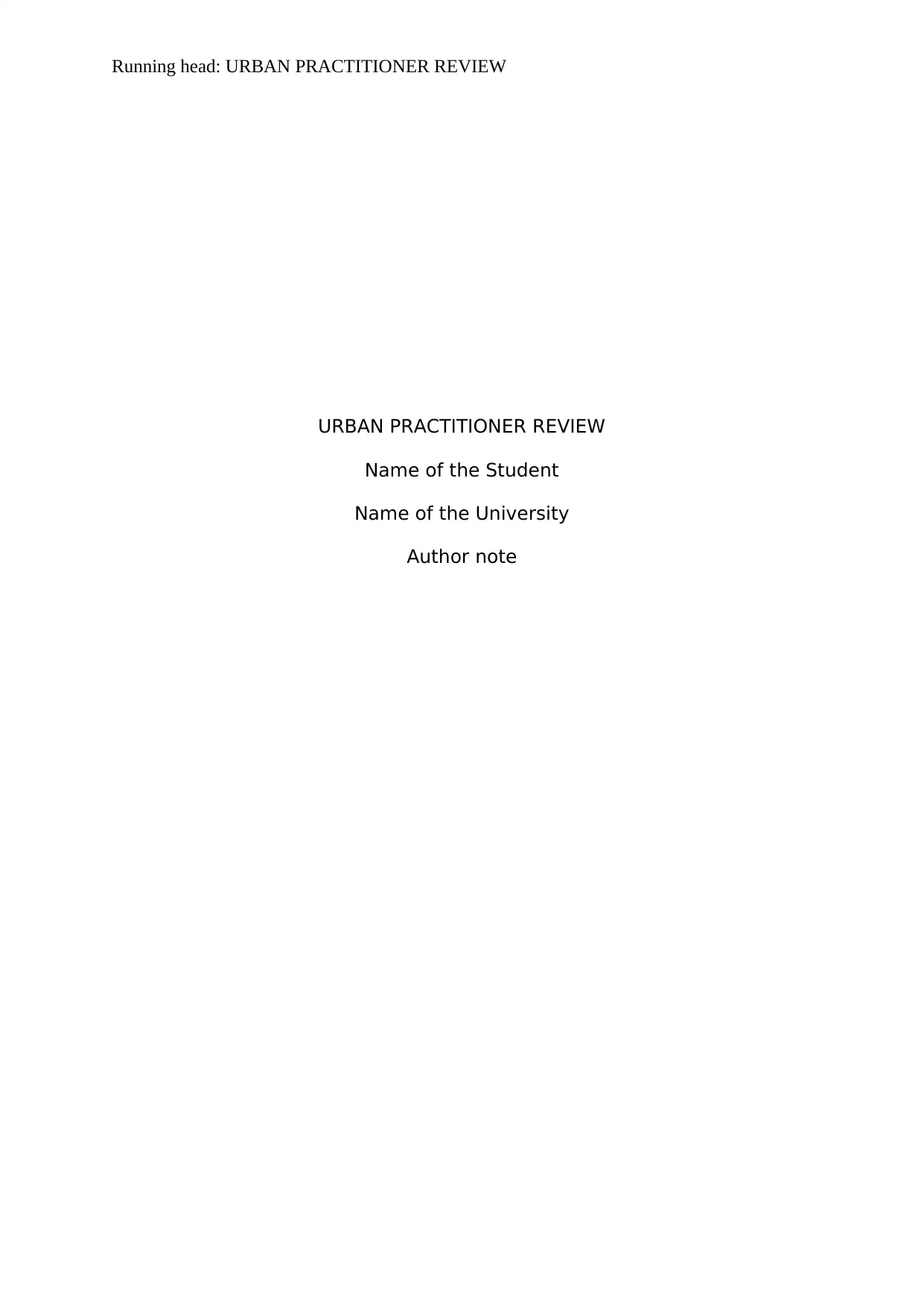
Running head: URBAN PRACTITIONER REVIEW
URBAN PRACTITIONER REVIEW
Name of the Student
Name of the University
Author note
URBAN PRACTITIONER REVIEW
Name of the Student
Name of the University
Author note
Paraphrase This Document
Need a fresh take? Get an instant paraphrase of this document with our AI Paraphraser
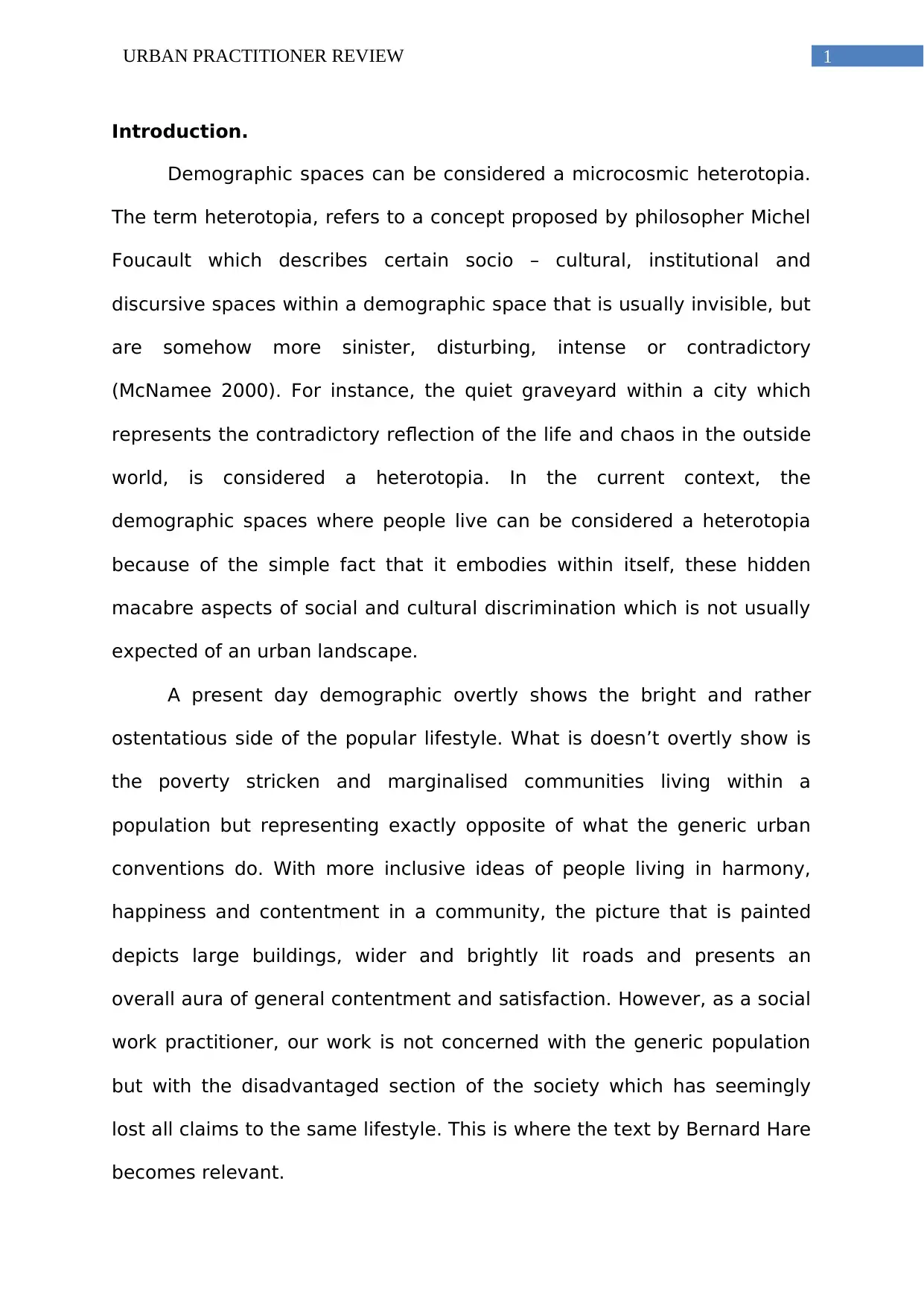
1URBAN PRACTITIONER REVIEW
Introduction.
Demographic spaces can be considered a microcosmic heterotopia.
The term heterotopia, refers to a concept proposed by philosopher Michel
Foucault which describes certain socio – cultural, institutional and
discursive spaces within a demographic space that is usually invisible, but
are somehow more sinister, disturbing, intense or contradictory
(McNamee 2000). For instance, the quiet graveyard within a city which
represents the contradictory reflection of the life and chaos in the outside
world, is considered a heterotopia. In the current context, the
demographic spaces where people live can be considered a heterotopia
because of the simple fact that it embodies within itself, these hidden
macabre aspects of social and cultural discrimination which is not usually
expected of an urban landscape.
A present day demographic overtly shows the bright and rather
ostentatious side of the popular lifestyle. What is doesn’t overtly show is
the poverty stricken and marginalised communities living within a
population but representing exactly opposite of what the generic urban
conventions do. With more inclusive ideas of people living in harmony,
happiness and contentment in a community, the picture that is painted
depicts large buildings, wider and brightly lit roads and presents an
overall aura of general contentment and satisfaction. However, as a social
work practitioner, our work is not concerned with the generic population
but with the disadvantaged section of the society which has seemingly
lost all claims to the same lifestyle. This is where the text by Bernard Hare
becomes relevant.
Introduction.
Demographic spaces can be considered a microcosmic heterotopia.
The term heterotopia, refers to a concept proposed by philosopher Michel
Foucault which describes certain socio – cultural, institutional and
discursive spaces within a demographic space that is usually invisible, but
are somehow more sinister, disturbing, intense or contradictory
(McNamee 2000). For instance, the quiet graveyard within a city which
represents the contradictory reflection of the life and chaos in the outside
world, is considered a heterotopia. In the current context, the
demographic spaces where people live can be considered a heterotopia
because of the simple fact that it embodies within itself, these hidden
macabre aspects of social and cultural discrimination which is not usually
expected of an urban landscape.
A present day demographic overtly shows the bright and rather
ostentatious side of the popular lifestyle. What is doesn’t overtly show is
the poverty stricken and marginalised communities living within a
population but representing exactly opposite of what the generic urban
conventions do. With more inclusive ideas of people living in harmony,
happiness and contentment in a community, the picture that is painted
depicts large buildings, wider and brightly lit roads and presents an
overall aura of general contentment and satisfaction. However, as a social
work practitioner, our work is not concerned with the generic population
but with the disadvantaged section of the society which has seemingly
lost all claims to the same lifestyle. This is where the text by Bernard Hare
becomes relevant.
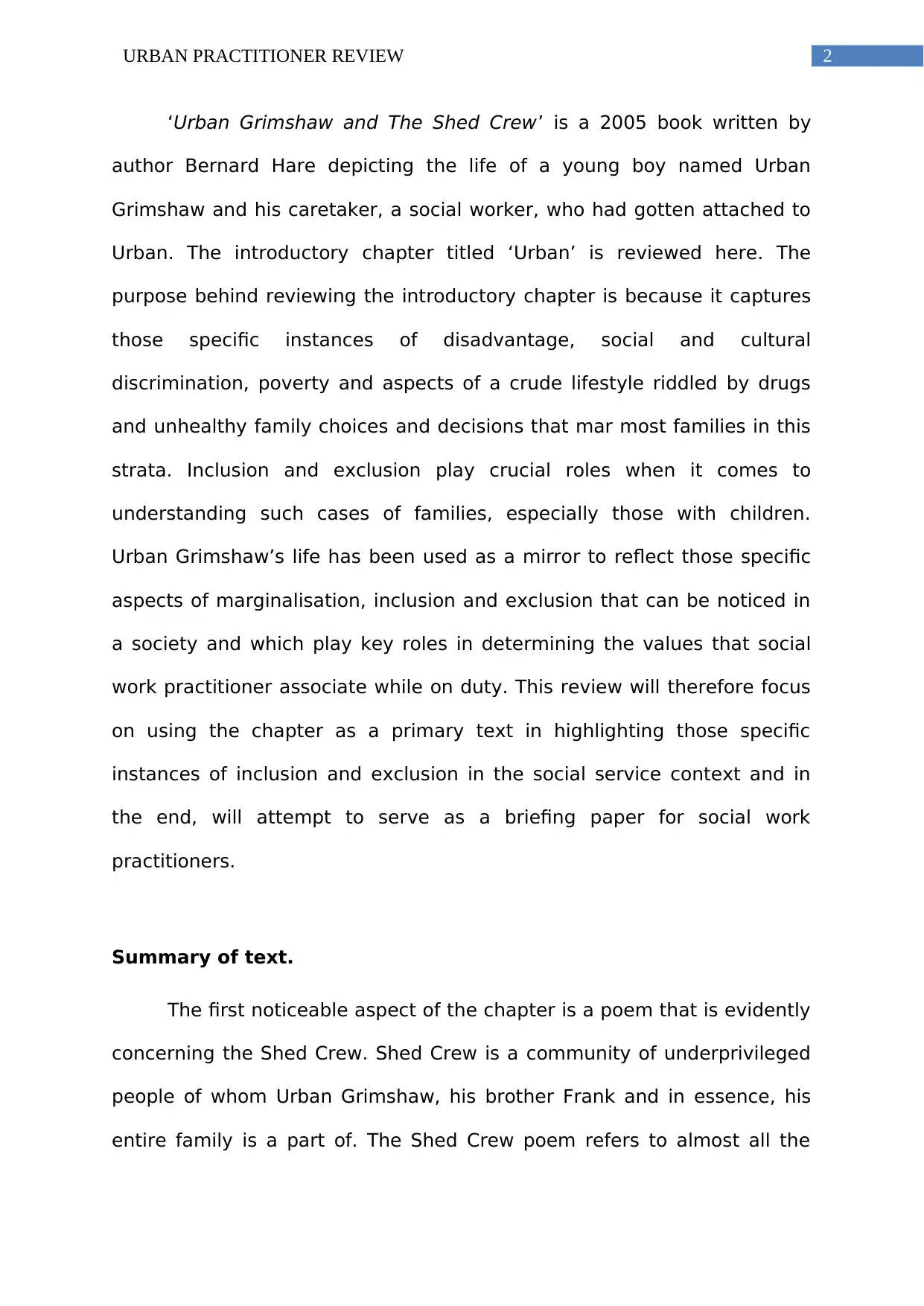
2URBAN PRACTITIONER REVIEW
‘Urban Grimshaw and The Shed Crew’ is a 2005 book written by
author Bernard Hare depicting the life of a young boy named Urban
Grimshaw and his caretaker, a social worker, who had gotten attached to
Urban. The introductory chapter titled ‘Urban’ is reviewed here. The
purpose behind reviewing the introductory chapter is because it captures
those specific instances of disadvantage, social and cultural
discrimination, poverty and aspects of a crude lifestyle riddled by drugs
and unhealthy family choices and decisions that mar most families in this
strata. Inclusion and exclusion play crucial roles when it comes to
understanding such cases of families, especially those with children.
Urban Grimshaw’s life has been used as a mirror to reflect those specific
aspects of marginalisation, inclusion and exclusion that can be noticed in
a society and which play key roles in determining the values that social
work practitioner associate while on duty. This review will therefore focus
on using the chapter as a primary text in highlighting those specific
instances of inclusion and exclusion in the social service context and in
the end, will attempt to serve as a briefing paper for social work
practitioners.
Summary of text.
The first noticeable aspect of the chapter is a poem that is evidently
concerning the Shed Crew. Shed Crew is a community of underprivileged
people of whom Urban Grimshaw, his brother Frank and in essence, his
entire family is a part of. The Shed Crew poem refers to almost all the
‘Urban Grimshaw and The Shed Crew’ is a 2005 book written by
author Bernard Hare depicting the life of a young boy named Urban
Grimshaw and his caretaker, a social worker, who had gotten attached to
Urban. The introductory chapter titled ‘Urban’ is reviewed here. The
purpose behind reviewing the introductory chapter is because it captures
those specific instances of disadvantage, social and cultural
discrimination, poverty and aspects of a crude lifestyle riddled by drugs
and unhealthy family choices and decisions that mar most families in this
strata. Inclusion and exclusion play crucial roles when it comes to
understanding such cases of families, especially those with children.
Urban Grimshaw’s life has been used as a mirror to reflect those specific
aspects of marginalisation, inclusion and exclusion that can be noticed in
a society and which play key roles in determining the values that social
work practitioner associate while on duty. This review will therefore focus
on using the chapter as a primary text in highlighting those specific
instances of inclusion and exclusion in the social service context and in
the end, will attempt to serve as a briefing paper for social work
practitioners.
Summary of text.
The first noticeable aspect of the chapter is a poem that is evidently
concerning the Shed Crew. Shed Crew is a community of underprivileged
people of whom Urban Grimshaw, his brother Frank and in essence, his
entire family is a part of. The Shed Crew poem refers to almost all the
⊘ This is a preview!⊘
Do you want full access?
Subscribe today to unlock all pages.

Trusted by 1+ million students worldwide

3URBAN PRACTITIONER REVIEW
significant members of the crew, including Greta, Urban’s mother, calling
her a junkie and a sex addict, Urban a thief, his dog Tyson as their interim
bodyguard, Frank as a sex offender (nonce) and many more. It also
describes the narrator Chop, as the moderately decent person in the flat.
In essence, the poem is a direct indication to the life in the British
wasteland, away from the hubbub of the generic city population and
lifestyle.
The chapter starts off by describing the setting – two overflowing
sewage pipes opposite the rather lush and ostentatious exterior of the
Royal Armouries Museum. Urban was sitting on the edge of the
comparatively drier right hand pipe. He blew into a small plastic bag
containing nail varnish and inhaled the air several times to get
intoxicated. Once the effects of the varnish sets in, Urban stands with his
arms outstretched sideways on the edge of the pipe while the narrator
and Urban’s family caretaker, Chop, calls out from behind.
The described place lies within an industrial construction zone with
construction workers moving in all directions. It is chaotic with the sounds
of machinery and people. In order to rescue Urban, Chop and the dog
Tyson stroll through the waters filled with human waste and other
garbage. As Chop slips, it gains Urban’s attention. He notices them and
after cursing them in the imaginary context that he has made up in his
intoxicated mind, Urban jumps into the river to which the sewage pipes
connect. Chp immediately takes off his external clothing and jump in the
river to save Urban. He manages to save a gasping Urban from drowning
and both apologise to each other.
significant members of the crew, including Greta, Urban’s mother, calling
her a junkie and a sex addict, Urban a thief, his dog Tyson as their interim
bodyguard, Frank as a sex offender (nonce) and many more. It also
describes the narrator Chop, as the moderately decent person in the flat.
In essence, the poem is a direct indication to the life in the British
wasteland, away from the hubbub of the generic city population and
lifestyle.
The chapter starts off by describing the setting – two overflowing
sewage pipes opposite the rather lush and ostentatious exterior of the
Royal Armouries Museum. Urban was sitting on the edge of the
comparatively drier right hand pipe. He blew into a small plastic bag
containing nail varnish and inhaled the air several times to get
intoxicated. Once the effects of the varnish sets in, Urban stands with his
arms outstretched sideways on the edge of the pipe while the narrator
and Urban’s family caretaker, Chop, calls out from behind.
The described place lies within an industrial construction zone with
construction workers moving in all directions. It is chaotic with the sounds
of machinery and people. In order to rescue Urban, Chop and the dog
Tyson stroll through the waters filled with human waste and other
garbage. As Chop slips, it gains Urban’s attention. He notices them and
after cursing them in the imaginary context that he has made up in his
intoxicated mind, Urban jumps into the river to which the sewage pipes
connect. Chp immediately takes off his external clothing and jump in the
river to save Urban. He manages to save a gasping Urban from drowning
and both apologise to each other.
Paraphrase This Document
Need a fresh take? Get an instant paraphrase of this document with our AI Paraphraser
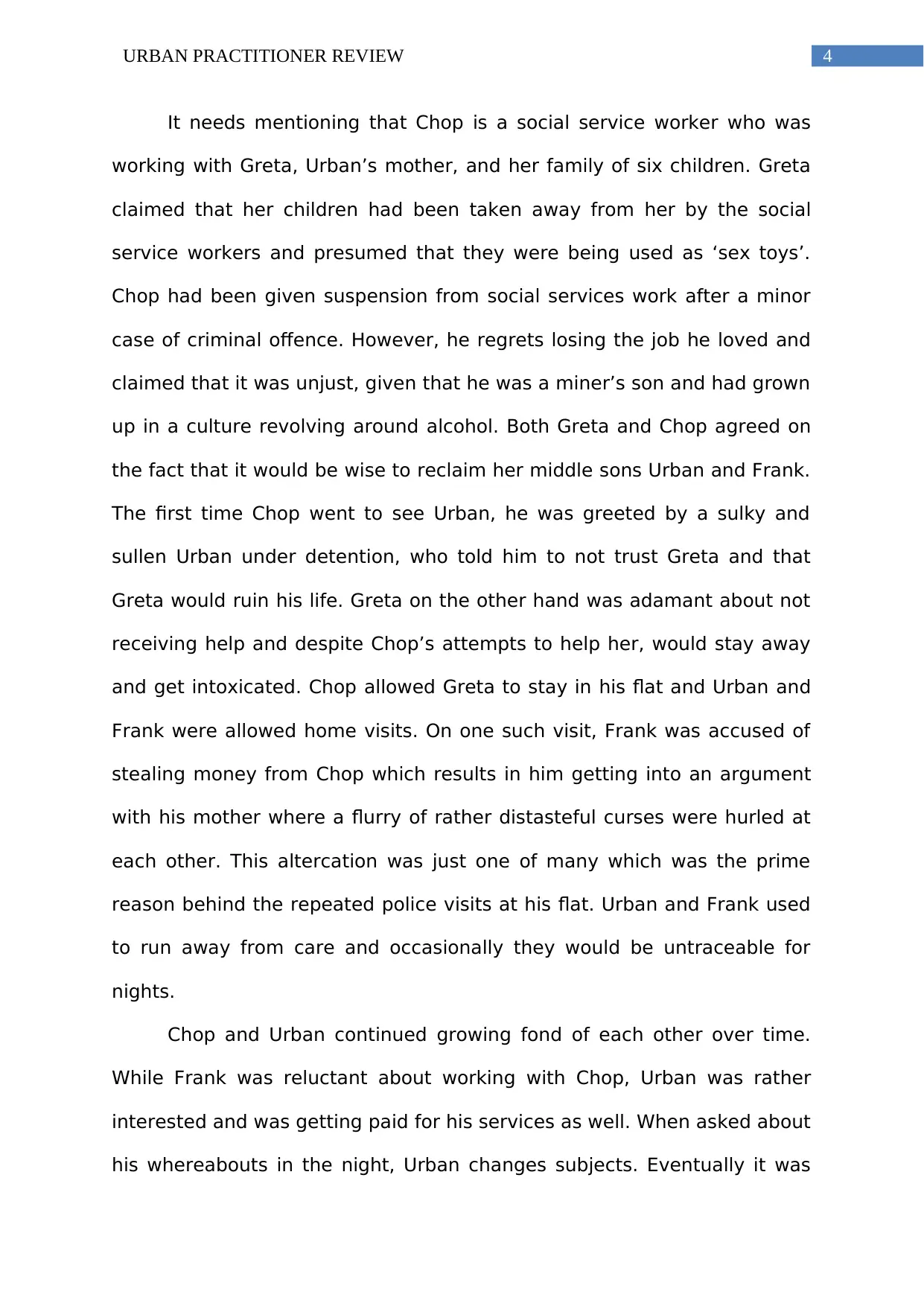
4URBAN PRACTITIONER REVIEW
It needs mentioning that Chop is a social service worker who was
working with Greta, Urban’s mother, and her family of six children. Greta
claimed that her children had been taken away from her by the social
service workers and presumed that they were being used as ‘sex toys’.
Chop had been given suspension from social services work after a minor
case of criminal offence. However, he regrets losing the job he loved and
claimed that it was unjust, given that he was a miner’s son and had grown
up in a culture revolving around alcohol. Both Greta and Chop agreed on
the fact that it would be wise to reclaim her middle sons Urban and Frank.
The first time Chop went to see Urban, he was greeted by a sulky and
sullen Urban under detention, who told him to not trust Greta and that
Greta would ruin his life. Greta on the other hand was adamant about not
receiving help and despite Chop’s attempts to help her, would stay away
and get intoxicated. Chop allowed Greta to stay in his flat and Urban and
Frank were allowed home visits. On one such visit, Frank was accused of
stealing money from Chop which results in him getting into an argument
with his mother where a flurry of rather distasteful curses were hurled at
each other. This altercation was just one of many which was the prime
reason behind the repeated police visits at his flat. Urban and Frank used
to run away from care and occasionally they would be untraceable for
nights.
Chop and Urban continued growing fond of each other over time.
While Frank was reluctant about working with Chop, Urban was rather
interested and was getting paid for his services as well. When asked about
his whereabouts in the night, Urban changes subjects. Eventually it was
It needs mentioning that Chop is a social service worker who was
working with Greta, Urban’s mother, and her family of six children. Greta
claimed that her children had been taken away from her by the social
service workers and presumed that they were being used as ‘sex toys’.
Chop had been given suspension from social services work after a minor
case of criminal offence. However, he regrets losing the job he loved and
claimed that it was unjust, given that he was a miner’s son and had grown
up in a culture revolving around alcohol. Both Greta and Chop agreed on
the fact that it would be wise to reclaim her middle sons Urban and Frank.
The first time Chop went to see Urban, he was greeted by a sulky and
sullen Urban under detention, who told him to not trust Greta and that
Greta would ruin his life. Greta on the other hand was adamant about not
receiving help and despite Chop’s attempts to help her, would stay away
and get intoxicated. Chop allowed Greta to stay in his flat and Urban and
Frank were allowed home visits. On one such visit, Frank was accused of
stealing money from Chop which results in him getting into an argument
with his mother where a flurry of rather distasteful curses were hurled at
each other. This altercation was just one of many which was the prime
reason behind the repeated police visits at his flat. Urban and Frank used
to run away from care and occasionally they would be untraceable for
nights.
Chop and Urban continued growing fond of each other over time.
While Frank was reluctant about working with Chop, Urban was rather
interested and was getting paid for his services as well. When asked about
his whereabouts in the night, Urban changes subjects. Eventually it was

5URBAN PRACTITIONER REVIEW
revealed that he spent his nights with the Shed Crew, a community of
older teenagers sharing a house.
Meanwhile Greta gets physically involved with some random male
much to the inconvenience of Chop, primarily because the encounter took
place in his flat. This resulted in Chop shifting Greta to a new house. He
later told Urban that he wanted his old life back and therefore did not
want to have any association with them anymore. This enrages Urban who
grew fond of Chop and he runs away. Later Chop is struck by remorse and
he goes looking for Urban, finding him at the sewers. They later get out of
the sewers, wet and shivering in the cold, rescue their dog Tyson and
Chop takes Urban to his mother for cleaner clothes, much to Urban’s
disdain.
Review of the text.
At the very outset, what we can most clearly see is the kind of
environment and lifestyle that has been presented here. It is not one that
resonates with the lifestyle of the city, rather depicts the dark and grim
underbelly of a rich, lavishing and privileged lifestyle. If we start analysing
from the poem onwards, particularly from the language used, the most
striking observation we can make is that the language lacks the
refinement that is present in the posh social lifestyle. According to
Thompson (2016), it would be a key indicator of the social division and
social structure present within (p. 27). Thompson states that the social
structures are not unified under one particular banner but are rather
consisting of a diverse range of people, characterised by a diverse range
revealed that he spent his nights with the Shed Crew, a community of
older teenagers sharing a house.
Meanwhile Greta gets physically involved with some random male
much to the inconvenience of Chop, primarily because the encounter took
place in his flat. This resulted in Chop shifting Greta to a new house. He
later told Urban that he wanted his old life back and therefore did not
want to have any association with them anymore. This enrages Urban who
grew fond of Chop and he runs away. Later Chop is struck by remorse and
he goes looking for Urban, finding him at the sewers. They later get out of
the sewers, wet and shivering in the cold, rescue their dog Tyson and
Chop takes Urban to his mother for cleaner clothes, much to Urban’s
disdain.
Review of the text.
At the very outset, what we can most clearly see is the kind of
environment and lifestyle that has been presented here. It is not one that
resonates with the lifestyle of the city, rather depicts the dark and grim
underbelly of a rich, lavishing and privileged lifestyle. If we start analysing
from the poem onwards, particularly from the language used, the most
striking observation we can make is that the language lacks the
refinement that is present in the posh social lifestyle. According to
Thompson (2016), it would be a key indicator of the social division and
social structure present within (p. 27). Thompson states that the social
structures are not unified under one particular banner but are rather
consisting of a diverse range of people, characterised by a diverse range
⊘ This is a preview!⊘
Do you want full access?
Subscribe today to unlock all pages.

Trusted by 1+ million students worldwide

6URBAN PRACTITIONER REVIEW
of characteristics (Thompson 2016, p. 27). Some of the bases of division
that he mentions, are class, gender, race, age, disability, sexuality and
religion (Thompson 2016). In the context of Urban, these factors overtly
play no identifiable role, but analysing from a deeper insight, we can see
how certain of these factors are intricately connected with the society
depicted in the chapter. Urban’s connections with the Shed Crew stands
as a burning example for the aspect of social divide. The Shed Crew calls
itself a group of miscreants openly, denouncing the socially accepted
norms of trying to conform to a general type.
In social service, it becomes important to understand factors like
social divide and discrimination in order to establish an empathic
understanding between the service provider and his clients. This is
therefore, where the social context becomes important to consider
(Thompson & Thompson 2015). Looking at Chop’s behaviour towards
Urban, we see a mix of emotions, starting from kindness generating out of
work ethics and compassion, to frustration because of his mother and
eventually turning into an almost fatherly love and care. Emotions play a
crucial role in the social service context and getting attached with the
clients can have a variety of impacts on both the practitioner and the
clients. For the clients, attachment on the part of the practitioner means
there is a guarantee of provisions and amenities, often resulting in
increased dependency and lack of self-reliance. For the practitioner,
attachment can be draining or finances, but most importantly can lead to
various mental health issues arising out of emotional turmoil, often
resulting in burnout or compassion fatigue (Adams, Boscarno and Figley
of characteristics (Thompson 2016, p. 27). Some of the bases of division
that he mentions, are class, gender, race, age, disability, sexuality and
religion (Thompson 2016). In the context of Urban, these factors overtly
play no identifiable role, but analysing from a deeper insight, we can see
how certain of these factors are intricately connected with the society
depicted in the chapter. Urban’s connections with the Shed Crew stands
as a burning example for the aspect of social divide. The Shed Crew calls
itself a group of miscreants openly, denouncing the socially accepted
norms of trying to conform to a general type.
In social service, it becomes important to understand factors like
social divide and discrimination in order to establish an empathic
understanding between the service provider and his clients. This is
therefore, where the social context becomes important to consider
(Thompson & Thompson 2015). Looking at Chop’s behaviour towards
Urban, we see a mix of emotions, starting from kindness generating out of
work ethics and compassion, to frustration because of his mother and
eventually turning into an almost fatherly love and care. Emotions play a
crucial role in the social service context and getting attached with the
clients can have a variety of impacts on both the practitioner and the
clients. For the clients, attachment on the part of the practitioner means
there is a guarantee of provisions and amenities, often resulting in
increased dependency and lack of self-reliance. For the practitioner,
attachment can be draining or finances, but most importantly can lead to
various mental health issues arising out of emotional turmoil, often
resulting in burnout or compassion fatigue (Adams, Boscarno and Figley
Paraphrase This Document
Need a fresh take? Get an instant paraphrase of this document with our AI Paraphraser
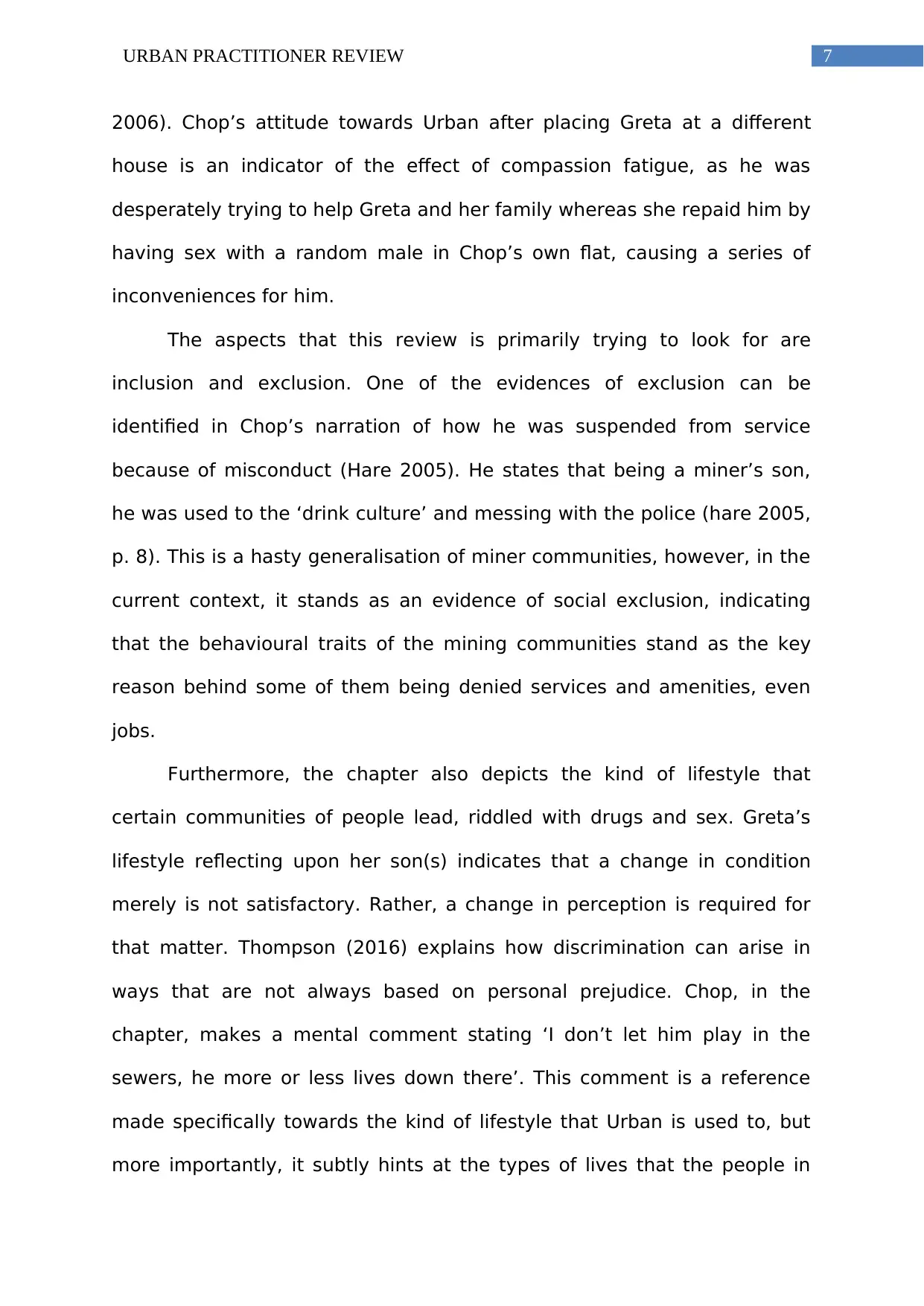
7URBAN PRACTITIONER REVIEW
2006). Chop’s attitude towards Urban after placing Greta at a different
house is an indicator of the effect of compassion fatigue, as he was
desperately trying to help Greta and her family whereas she repaid him by
having sex with a random male in Chop’s own flat, causing a series of
inconveniences for him.
The aspects that this review is primarily trying to look for are
inclusion and exclusion. One of the evidences of exclusion can be
identified in Chop’s narration of how he was suspended from service
because of misconduct (Hare 2005). He states that being a miner’s son,
he was used to the ‘drink culture’ and messing with the police (hare 2005,
p. 8). This is a hasty generalisation of miner communities, however, in the
current context, it stands as an evidence of social exclusion, indicating
that the behavioural traits of the mining communities stand as the key
reason behind some of them being denied services and amenities, even
jobs.
Furthermore, the chapter also depicts the kind of lifestyle that
certain communities of people lead, riddled with drugs and sex. Greta’s
lifestyle reflecting upon her son(s) indicates that a change in condition
merely is not satisfactory. Rather, a change in perception is required for
that matter. Thompson (2016) explains how discrimination can arise in
ways that are not always based on personal prejudice. Chop, in the
chapter, makes a mental comment stating ‘I don’t let him play in the
sewers, he more or less lives down there’. This comment is a reference
made specifically towards the kind of lifestyle that Urban is used to, but
more importantly, it subtly hints at the types of lives that the people in
2006). Chop’s attitude towards Urban after placing Greta at a different
house is an indicator of the effect of compassion fatigue, as he was
desperately trying to help Greta and her family whereas she repaid him by
having sex with a random male in Chop’s own flat, causing a series of
inconveniences for him.
The aspects that this review is primarily trying to look for are
inclusion and exclusion. One of the evidences of exclusion can be
identified in Chop’s narration of how he was suspended from service
because of misconduct (Hare 2005). He states that being a miner’s son,
he was used to the ‘drink culture’ and messing with the police (hare 2005,
p. 8). This is a hasty generalisation of miner communities, however, in the
current context, it stands as an evidence of social exclusion, indicating
that the behavioural traits of the mining communities stand as the key
reason behind some of them being denied services and amenities, even
jobs.
Furthermore, the chapter also depicts the kind of lifestyle that
certain communities of people lead, riddled with drugs and sex. Greta’s
lifestyle reflecting upon her son(s) indicates that a change in condition
merely is not satisfactory. Rather, a change in perception is required for
that matter. Thompson (2016) explains how discrimination can arise in
ways that are not always based on personal prejudice. Chop, in the
chapter, makes a mental comment stating ‘I don’t let him play in the
sewers, he more or less lives down there’. This comment is a reference
made specifically towards the kind of lifestyle that Urban is used to, but
more importantly, it subtly hints at the types of lives that the people in

8URBAN PRACTITIONER REVIEW
Urban’s social strata are used to living. Chop further narrates how Urban
hates the care because he get bullied physically and sexually, while he is
riddled by pathogens of ‘ignorance, destitution, addiction and want’ (Hare
2005, p. 14). This is a direct indicator towards the community lifestyle and
the instances of discrimination and exclusion that Urban had to face
growing up (Thompson 2016). This kind of a lifestyle is fa away from what
people in the innards of the city are used to or even care to imagine. In
essence the chapter provides a variety of reasons and instances depicting
instances of exclusion, in the form of marginalisation, social divide, class
difference and personal aspects of disadvantage. The only aspect of
inclusion it shows is Urban’s little second family of the Shed Crew,
indicating that people standing on the same precarious grounds, find the
will to bond together, not as a means of socialisation, but purely out of the
innate instincts of survival.
Conclusion.
In conclusion, we can say that the chapter presents crucial aspects
of evidence towards the variety of socio – cultural divide that separates
the disadvantaged people from the general crowd. A page out of Urban’s
Urban’s social strata are used to living. Chop further narrates how Urban
hates the care because he get bullied physically and sexually, while he is
riddled by pathogens of ‘ignorance, destitution, addiction and want’ (Hare
2005, p. 14). This is a direct indicator towards the community lifestyle and
the instances of discrimination and exclusion that Urban had to face
growing up (Thompson 2016). This kind of a lifestyle is fa away from what
people in the innards of the city are used to or even care to imagine. In
essence the chapter provides a variety of reasons and instances depicting
instances of exclusion, in the form of marginalisation, social divide, class
difference and personal aspects of disadvantage. The only aspect of
inclusion it shows is Urban’s little second family of the Shed Crew,
indicating that people standing on the same precarious grounds, find the
will to bond together, not as a means of socialisation, but purely out of the
innate instincts of survival.
Conclusion.
In conclusion, we can say that the chapter presents crucial aspects
of evidence towards the variety of socio – cultural divide that separates
the disadvantaged people from the general crowd. A page out of Urban’s
⊘ This is a preview!⊘
Do you want full access?
Subscribe today to unlock all pages.

Trusted by 1+ million students worldwide
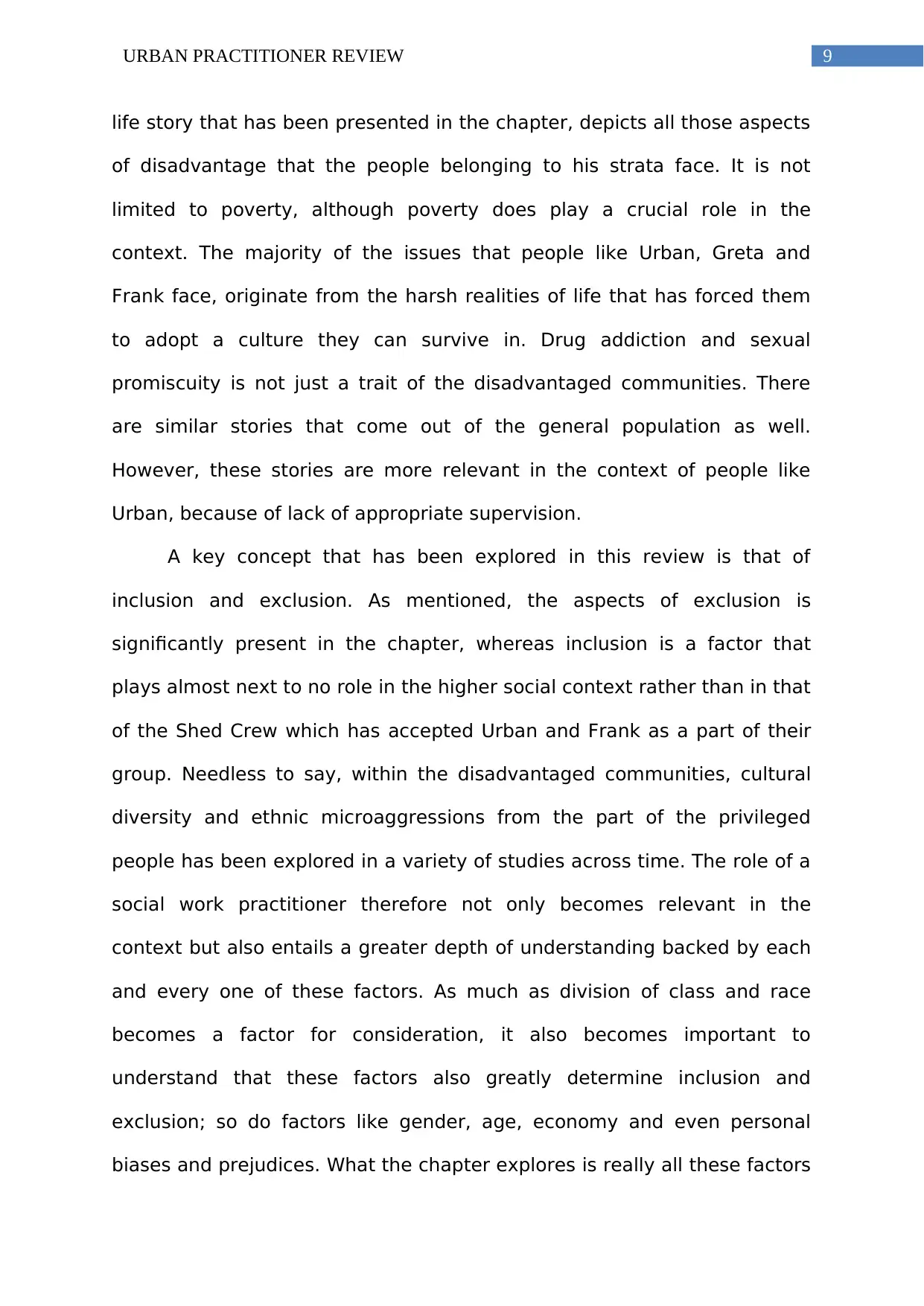
9URBAN PRACTITIONER REVIEW
life story that has been presented in the chapter, depicts all those aspects
of disadvantage that the people belonging to his strata face. It is not
limited to poverty, although poverty does play a crucial role in the
context. The majority of the issues that people like Urban, Greta and
Frank face, originate from the harsh realities of life that has forced them
to adopt a culture they can survive in. Drug addiction and sexual
promiscuity is not just a trait of the disadvantaged communities. There
are similar stories that come out of the general population as well.
However, these stories are more relevant in the context of people like
Urban, because of lack of appropriate supervision.
A key concept that has been explored in this review is that of
inclusion and exclusion. As mentioned, the aspects of exclusion is
significantly present in the chapter, whereas inclusion is a factor that
plays almost next to no role in the higher social context rather than in that
of the Shed Crew which has accepted Urban and Frank as a part of their
group. Needless to say, within the disadvantaged communities, cultural
diversity and ethnic microaggressions from the part of the privileged
people has been explored in a variety of studies across time. The role of a
social work practitioner therefore not only becomes relevant in the
context but also entails a greater depth of understanding backed by each
and every one of these factors. As much as division of class and race
becomes a factor for consideration, it also becomes important to
understand that these factors also greatly determine inclusion and
exclusion; so do factors like gender, age, economy and even personal
biases and prejudices. What the chapter explores is really all these factors
life story that has been presented in the chapter, depicts all those aspects
of disadvantage that the people belonging to his strata face. It is not
limited to poverty, although poverty does play a crucial role in the
context. The majority of the issues that people like Urban, Greta and
Frank face, originate from the harsh realities of life that has forced them
to adopt a culture they can survive in. Drug addiction and sexual
promiscuity is not just a trait of the disadvantaged communities. There
are similar stories that come out of the general population as well.
However, these stories are more relevant in the context of people like
Urban, because of lack of appropriate supervision.
A key concept that has been explored in this review is that of
inclusion and exclusion. As mentioned, the aspects of exclusion is
significantly present in the chapter, whereas inclusion is a factor that
plays almost next to no role in the higher social context rather than in that
of the Shed Crew which has accepted Urban and Frank as a part of their
group. Needless to say, within the disadvantaged communities, cultural
diversity and ethnic microaggressions from the part of the privileged
people has been explored in a variety of studies across time. The role of a
social work practitioner therefore not only becomes relevant in the
context but also entails a greater depth of understanding backed by each
and every one of these factors. As much as division of class and race
becomes a factor for consideration, it also becomes important to
understand that these factors also greatly determine inclusion and
exclusion; so do factors like gender, age, economy and even personal
biases and prejudices. What the chapter explores is really all these factors
Paraphrase This Document
Need a fresh take? Get an instant paraphrase of this document with our AI Paraphraser

10URBAN PRACTITIONER REVIEW
shaping the attitude and perception of a social service worker dealing
service to a client and getting attached to the family in a rather unusual
way. From a psychological perspective, attachment with the client can
have deeply emotional effects on the clients as well as the practitioners,
drawing forth reserves of empathy and compassion and juxtaposing them
with personal life and choices. This becomes an even more complicated
factor to consider when young children are considered. Young children are
more prone to developing bonds with adults who provide for them.
Therefore, making promises that cannot be fulfilled becomes problematic
for the children as they are unable to understand where a significant
support system of their lives have disappeared, once the bond breaks.
Practice is an experience for a lifetime, the relationships developed during
practice are not. It is therefore important to understand certain limits and
restrictions.
shaping the attitude and perception of a social service worker dealing
service to a client and getting attached to the family in a rather unusual
way. From a psychological perspective, attachment with the client can
have deeply emotional effects on the clients as well as the practitioners,
drawing forth reserves of empathy and compassion and juxtaposing them
with personal life and choices. This becomes an even more complicated
factor to consider when young children are considered. Young children are
more prone to developing bonds with adults who provide for them.
Therefore, making promises that cannot be fulfilled becomes problematic
for the children as they are unable to understand where a significant
support system of their lives have disappeared, once the bond breaks.
Practice is an experience for a lifetime, the relationships developed during
practice are not. It is therefore important to understand certain limits and
restrictions.

11URBAN PRACTITIONER REVIEW
References.
Adams, R.E., Boscarino, J.A. and Figley, C.R., 2006. Compassion fatigue
and psychological distress among social workers: A validation
study. American Journal of orthopsychiatry, 76(1), pp.103-108.
Hare, B., 2005. Urban Grimshaw and the Shed Crew. Hachette UK.
McNamee, S., 2000. Foucault's heterotopia and children's everyday
lives. Childhood, 7(4), pp.479-492.
Thompson, N. and Thompson, S., 2015. The social work companion.
Macmillan International Higher Education.
Thompson, N., 2016. Anti-discriminatory practice: Equality, diversity and
social justice. Macmillan International Higher Education.
References.
Adams, R.E., Boscarino, J.A. and Figley, C.R., 2006. Compassion fatigue
and psychological distress among social workers: A validation
study. American Journal of orthopsychiatry, 76(1), pp.103-108.
Hare, B., 2005. Urban Grimshaw and the Shed Crew. Hachette UK.
McNamee, S., 2000. Foucault's heterotopia and children's everyday
lives. Childhood, 7(4), pp.479-492.
Thompson, N. and Thompson, S., 2015. The social work companion.
Macmillan International Higher Education.
Thompson, N., 2016. Anti-discriminatory practice: Equality, diversity and
social justice. Macmillan International Higher Education.
⊘ This is a preview!⊘
Do you want full access?
Subscribe today to unlock all pages.

Trusted by 1+ million students worldwide
1 out of 12
Your All-in-One AI-Powered Toolkit for Academic Success.
+13062052269
info@desklib.com
Available 24*7 on WhatsApp / Email
![[object Object]](/_next/static/media/star-bottom.7253800d.svg)
Unlock your academic potential
Copyright © 2020–2025 A2Z Services. All Rights Reserved. Developed and managed by ZUCOL.